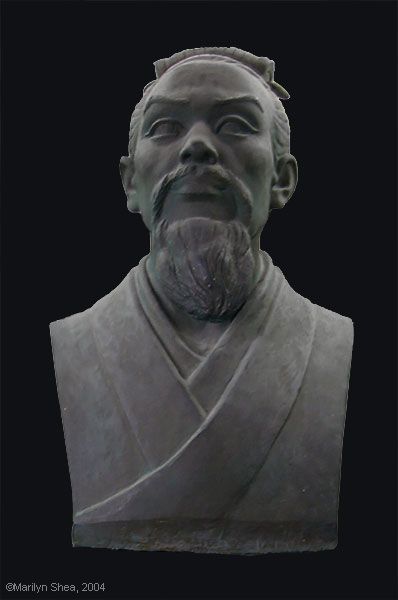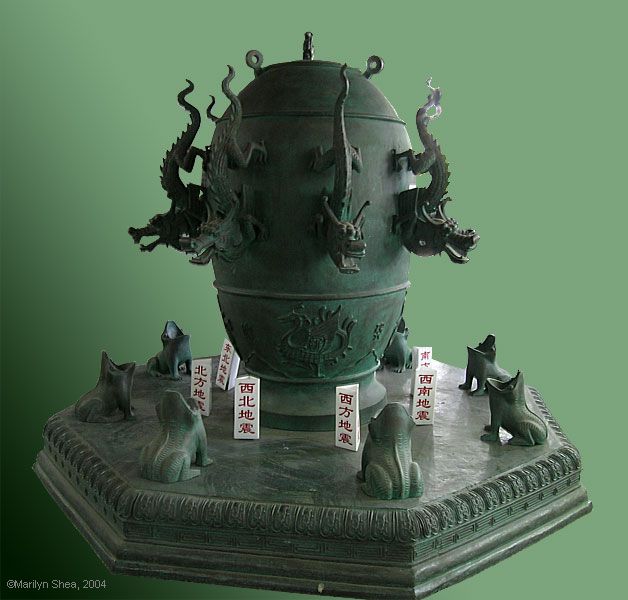 |
| Zhang Heng was an astronomer, mathematician, engineer, and painter who lived during the Eastern Han Dynasty (25-220 AD, 东汉 Dōng Hàn). He served during the reigns of Emperors Āndì 安帝 (94-125) and Shùndì 順帝 (125-144). He is one of a long line of astronomers who served the emperors through the various dynasties. Astronomers served an important function of State by creating and maintaining calendars, making predictions concerning celestial events, and keeping records of the events observed in the heavens. The belief that the organization of civil life was a reflection of and controlled by the heavens demanded careful attention to events that might influence government.
The Han Dynasty was a time of enormous progress in every area of knowledge and civilization. The travel along the Silk Road to India and beyond both brought new ideas from other cultures and great wealth. The stability of the period allowed attention to be paid to the growth of knowledge and the finer arts with the resources to support these endeavors. Zhang Heng soaked in the influences from every source and excelled in most fields. In mathematics he estimated the value of π pi as the square root of 10 or 3.1622. He invented a cart to measure lǐ 里, the Chinese mile. (Three Chinese li are roughly equivalent to an English mile.) It was the first odometer. In his treatise, Líng Xiàn (灵宪 Mystical Laws), he proposed a theory of the universe that compared it to an egg. "The sky is like a hen's egg and is as round as a crossbow pellet. The Earth is like the yolk of the egg, lying alone at the center. The sky is large and the Earth is small." The universe originated from chaos or yuánqì (元气). He said that the sun, moon, and planets were on the inside of the sphere and moved at different rates. He explained lunar eclipses and demonstrated the process with an armillary such as the one shown below. He demonstrated that the moon did not have independent light but that it merely reflected the light from the sun. He showed that lunar eclipses occurred relatively frequently because the moon moved faster within the sphere of the heavens. |
After Zhang Heng, Ge Heng of the Wu (229 to 280) in the Three Kingdom Period and then Qian Lezhi (Liu Song Dynasty 420-478) also developed water powered armillary spheres. In 721 AD the monk Yi Xing 一行 and the military engineer Liang Lingzan and others designed and made a water powered armillary that was an improvement on Zhang Heng's. This one not only could demonstrate apparent motion of celestial bodies, but also installed two wooden men who hit a drum to sound the time. It used an escapement method to equally divide the power from a water wheel and transmit it to the armillary. The stars could move according to time but the planets also moved in their irregular patterns by means of a series of bronze wheels. They installed it on the grounds of the palace in the capital Chang'an. During the Northern Song Dynasty, an amateur astronomer, Zhang Sichun, made a huge water powered armillary in 979 AD on the basis of the previous armillary spheres designed in the Han and Tang dynasties. It was 3.3 meters high. The peak of the technology (1092 AD) came during the Song Dynasty. Su Song and Han Gonglian made the most complicated and most elaborate powered armillary; it had three parts and was very tall. After they finished that one, Su Song and Han Gonglian and others made another one, even taller than a person. In this globe you looked through a pinhole to see the lights of the stars reflected on the inside. The light source was outside of the globe. Modern versions have the light source inside the globe so that they can project as in a planetarium or they glow and the surface is examined like a globe. After Su Song and Han Gonglian, Guō Shǒujìng 郭守敬 of the Yuan Dynasty (1279-1368) built one as well. It was named Ling Long Yi. The celestial globe in the illustration is an electrically modified version modeled on an example from the Qing Dynasty. It is displayed at the Ancient Observatory in Beijing (古观象台). |
| The seismometer (候風地動儀 hòufēng dìdòng yí) that Zhang Heng invented in 132 AD was an urn with some type of pendulum apparatus contained within it. We don't know the exact mechanics because they were lost in history. The pendulum was extremely sensitive to vibration. When it swung it released a ball from the mouth of one of eight dragons and the ball fell into the mouth of a patiently waiting frog. The loud clang that resulted notified attendants of some sort of seismological event. It is said that one day the ball fell but people in the court felt nothing. A few days later a runner arrived from a village 400 miles away to inform the Emperor that his area had been devastated by an earthquake. While Zhang Heng's seismograph couldn't predict a quake it could notify the court when one occurred so that aid could be sent.
China has been plagued by quakes through history. The most recent major quake was the Tangshan earthquake in 1976 measuring 8.2 on the Richter scale. Tangshan is on the north China plane. The quake killed more than a quarter million people. There is frequent activity along the Gansu Corridor, the Shanxi plateau, the Xi'an (Chang'an) area, the Beijing area, and the western and northern edges of the north China plain. In the east, from Shenyang in the north to Nanjing in the south, there are moderately frequent quakes. The western provinces of Sichuan, Yunnan, Tibet, and Xinjiang also have high levels of quake activity. In the south quakes are centered on the Fujian coast and Taiwan. For that reason, China is a major source of earthquake detection and prediction research. Historical records are of great interest to study both the risk level and to look for patterns over time. As part of that research, Feng Rui and Yu Yan-xiang (2006, Institute of Geophysics, China Earthquake Administration) concluded that the earthquake that first set off Zhang Heng's seismograph was magnitude 7 in Longxi with an epicenter at Tianshui on December 13, 134 AD. |
 |
| Below is a detailed view of the dragon's head with the frog receptacle. This model of Zhang Heng's seismograph stands in the Ancient Observatory in Beijing. It is about 5.5 feet tall. The modern signs indicate the compass directions. |
 |
http://hua.umf.maine.edu/China/beijing2.html
Last
update: May 2007
© Marilyn Shea, 2007